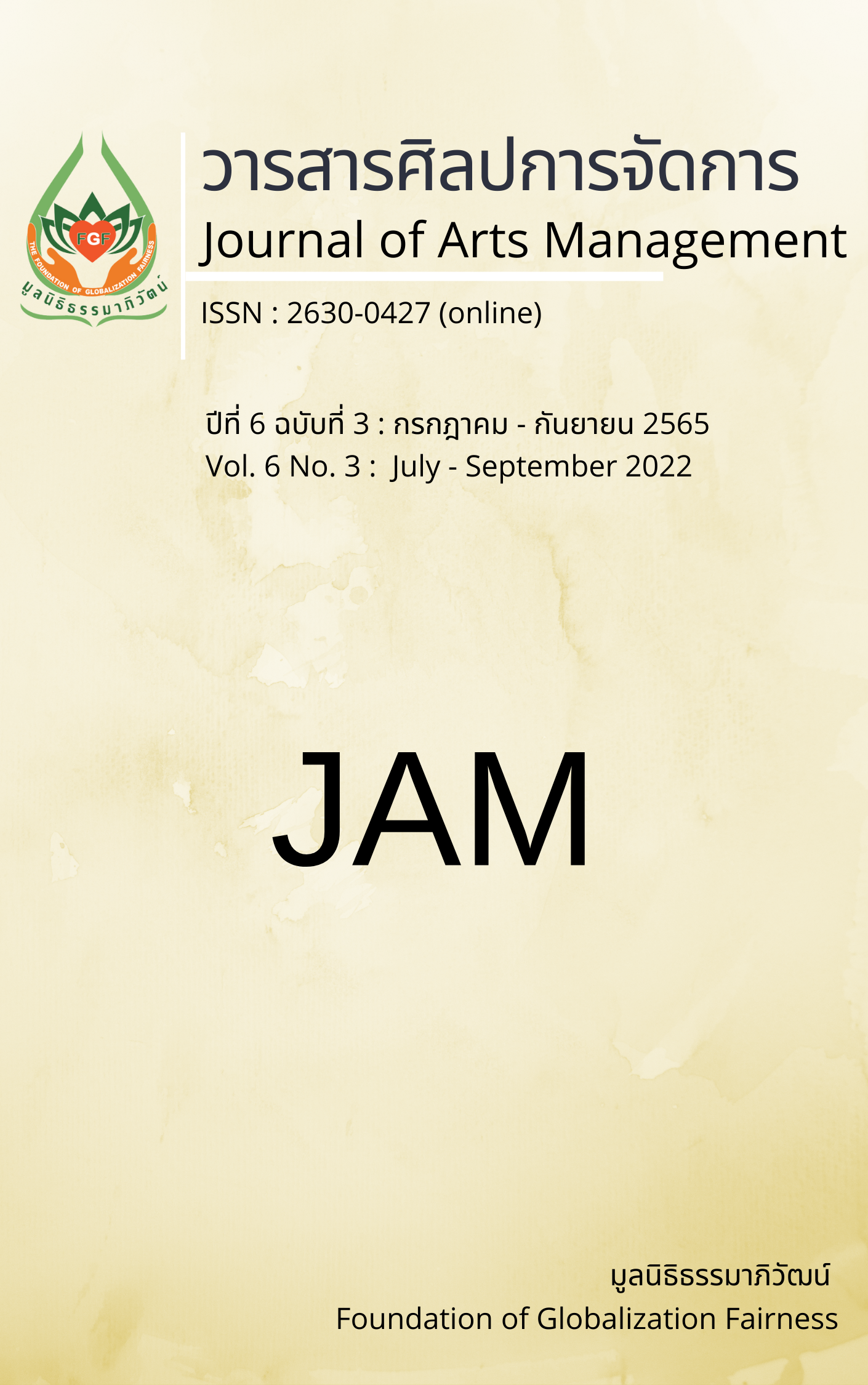Development of a Learning Management Model for Enhancing Cultural Sensitivity Characteristic in Nursing Students
Main Article Content
Abstract
The development of a learning management model for enhancing cultural sensitivity characteristics in nursing students had the objectives to study cultural sensitivity characteristics in nursing students and to development and study the effectiveness of a learning management model for enhancing cultural sensitivity characteristics in nursing students. There were three research and development phases: The first phase was to study of cultural sensitivity characteristics and create a tool to assess cultural sensitivity characteristics for nursing students, Interview of nurses and nursing instructors who received an award for outstanding performance and patient with a total of 16 informants; Phase 2: development of a learning management model for enhancing cultural sensitivity characteristics in nursing students; Phase 3: evaluation of the effectiveness and improvement of a learning management model for enhancing cultural sensitivity characteristics in nursing students. The sample consisted of 24 nursing students in the third year of the Faculty of Nursing at Kasembundit University, selected by cluster random sampling. The results showed that 1) the cultural sensitivity characteristic of nursing students consisted of 2 components: Understanding cultural differences and cultural response 2) The developed learning management model consisted of four steps: Step 1: Be open to cultural experiences; step 2: Analyze cultural problems; step 3: Make culturally sensitive decisions in nursing practice; and step 4: Share cultural experiences. 3) The effectiveness of the learning management model was as follows: (1) the mean scores of cultural sensitivity characteristic of nursing student after learning model increase constantly with statistically significant at the .05 level and (2) Comparison of the mean score of cultural sensitivity characteristic of nursing student after the learning model were higher than before the learning management model with statistically significant at the .05 level.
Article Details

This work is licensed under a Creative Commons Attribution-NonCommercial-NoDerivatives 4.0 International License.
Views and opinions appearing in articles in the Journal of Arts of Management It is the responsibility of the author of the article. and does not constitute the view and responsibility of the editorial team I agree that the article is copyright of the Arts and Management Journal.
References
Advent Health University. (2020, March 12). Guide to cultural sensitivity in nursing. AHU. https://online.ahu.edu/blog/infographic/guide-to-cultural-sensitivity-in-nursing/
Aksoy, Z. (2012). International migration and intercultural communication. Journal of International Social Research, 5(20), 292–303.
Amineh, R. J., & Asl, H. D. (2015). Review of Constructivism and Social Constructivism. Journal of Social Sciences, Literature and Languages, 1(1), 9-16.
Campinha-Bacote, J. (2011). Coming to know cultural competence: an evolutionary process. International Journal for Human Caring, 15(3), 42-48. https://doi.org/:10.20467/1091-5710.15.3.42
Chang, H., Yang, Y., & Kuo, Y. (2013). Cultural sensitivity and related factors among community health nurses. Journal of Nursing Research, 21(1), 67-73.
Cruz, J. P., Estacio, F. C., Bagtang, C. E., & Colet, P. C. (2016). Predictors of cultural competence among nursing students in the Philippines: Across-sectional study. Nurse Education Today, 46, 121-126. https://doi.org/10.1016/j.nedt.2016.09.001
Cupelli, L. (2016). An innovative service-learning project to develop cultural competency in undergraduate nursing students. Teaching and Learning in Nursing, 11(3), 113-117. https://doi.org/10.1016/j.teln.2016.01.004
Every Nurse Staff. (2022, January 15). Seven steps to become a more culturally sensitive nurse. everynurse. https://everynurse.org/blog/7-steps-culturally-sensitive-nurse/
Foronda, C. (2008). A concept analysis of cultural sensitivity. Journal of Transcultural Nursing, 19(3), 207-212. https://doi.org/10.1177/1043659608317093
Giovanangeli, A., & Oguro, S. (2016). Cultural Responsiveness: a framework for re-thinking students’interculturality through study abroad. Intercultural Education, 27(1), 70-84. https://doi.org/10.1080/14675986.2016.1144328
Göl, I., & Erkin, Ö. (2019). Association between cultural intelligence and cultural sensitivity in nursing students: A cross-sectional descriptive study. Collegian Journal of the Royal College of Nursing Australia, 26, 485–491. https://doi.org/10.1016/j.colegn.2018.12.007
Khammanee, T. (2016). Pedagogical Science: Knoeledge for effective learning process management (21st ed.). Chulalongkorn University.
Kolb, D. A. (1984). Experiential learning: Experience as the source of learning and development. Prentice Hall.
Koo T. K., & Li, M. Y. (2016). A guideline of selecting and reporting intraclass correlation coefficients for reliability research. Journal of Chiropractice Medicine. 15(2), 155-163. https://doi.org/10.1016/j.jcm.2016.02.012
Kraut, N. (2021, April 1). The imperative for providing culturally sensitive nursing care. healthstream. https://bit.ly/2DtWvzM
Leininger, M., & McFarland, M. R. (2002). Transcultural nursing: concepts, theories, research & practice (3rd ed). McGraw-Hill Companies.
Marion, L., Douglas, M., Lavin, M., Barr, N., Gazaway, S., Thomas, L., & Bickford, C. (2016). Implementing the new ANA standard 8: Culturally congruent practice. The Online Journal of Issues in Nursing, 22(1), 9-18. https://doi.org/10.3912/OJIN.Vol22No01PPT20
Puttaruksa, L. (2016). The role of nursing instructors in applying the concept of transcultural nursing into practice. Nursing Journal of the Ministry of Public Health, 26(2), 11-22.
Raman, J. (2015). Improved health and wellness outcomes in ethnically/culturally diverse patients through enhanced cultural competency in nurse educators. Journal of Cultural Competence in Nursing and Healthcare, 5(1), 104-177. https://doi.org/10.9730/ojccnh.org/v5i1a8
Roland, A. (2002). Cultural encounter with the health care system and ethnic minorities. Journal of Nursing Research, 2, 17–21.
Tashiro, J., Shimpuku, Y., Naruse, K., Maftuhah., & Matsutani, M. (2013). Concept analysis of reflection in nursing professional development. Japan Journal of Nursing Science, 10, 170–179. https://doi.org/10.1111/j.1742-7924.2012.00222.x
Unver, V., Uslu, Y., Kocatepe, V., & Kuguoglu, S. (2019). Evaluation of cultural sensitivity in healthcare service among nursing students. European Journal of Educational Research, 8(1), 257-265. https://doi.org/10.12973/eu-jer.8.1.257
Uzun, O., & Sevinç, S. (2015). The relationship between cultural sensitivity and perceived stress among nurses working with foreign patients. Journal of Clinical Nursing, 24, 3400-3408. https://doi.org/10.1111/jocn.12982


